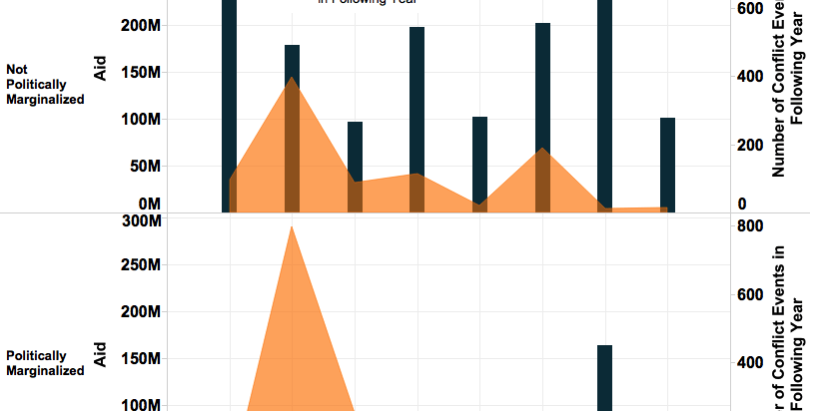With aid to developing countries at an all time high (OECD, 2014), aid effectiveness – as well as the possible detrimental effects of aid – have been gaining increased attention from both the academic and policy worlds. One of these detrimental effects is the relationship between aid and conflict – especially given the further burden conflict can be on a state when pursuing development goals.
The relationship between aid and conflict, and the role of inequality, is clearer when using the most recent, disaggregated information on each critical parameter, including georeferenced conflict data from ACLED showing where conflict has occurred; georeferenced aid data from Findley et al. (2011a) and AidData to determine where aid projects are located;[1] and ethnic group mapping and political hierarchies from Raleigh (2014) based on the GeoEPR dataset to determine where ethnic groups are located and what groups are politically marginalized.
Reports and studies describe the aid and conflict nexus in a variety of ways. Some argue that large inflows of aid can increase the ‘prize’ of conflict (especially if aid is lootable), hence increasing the opportunity for unrest (Collier & Hoeffler, 2004; Fearon & Laitin, 2003). This argument would suggest that regions that receive a large amount of aid inflows in a given year might subsequently see higher instances of conflict, though the data suggest that there is only about a 0.3 correlation between the two. This contests the notion that large aid flows increase the size of the ‘pie’, making conflict more attractive to greedy individuals as these findings suggest that more aid will not necessarily lead to more conflict.
A question often asked about the interaction of aid and conflict is how one can determine whether aid fuels conflict, or whether aid goes to regions that have been experiencing conflict. Arguably, this would suggest that the relationship between the two may not be as ominous as some expect. This argument suggests that regions seeing high instances of conflict in a given year might subsequently see high aid inflows, though the data suggest that there is again only about a 0.3 correlation between the two. This challenges the argument that the relationship between aid and conflict is simply a function of aid going to conflict zones.
Lastly, many argue that in political patronage-systems – seen in much of Africa – where those in power use public (state) resources for personal gain (e.g., to reward individuals for their electoral support in order to remain in favor), aid can be used as a form of patronage (Mwenda & Tangri, 2005; Chabal & Daloz, 1999), with aid often going to regions that house political in-groups (e.g., leaders’ home areas, or areas home to ethnic kin) to the detriment of political out-groups (Dreher et al., 2014). This argument would suggest that regions that house political in-groups receive more aid while regions that house politically marginalized groups (i.e., groups that are powerless in the political arena, or those that are actively discriminated against in the political sphere) do not, with regions that house these politically marginalized groups seeing more conflict resulting from their high grievances. Figure 1 compares aid flows in administrative units that house politically marginalized groups versus administrative units that do not in states where aid flows are directed towards political in-groups. In these states, administrative units that house politically marginalized groups only receive about 20% of total aid; as a result, these regions see over 63% of total conflict in these states. This lends credence to the notion that when aid flows lie along patronage channels and are appropriated as such, to the detriment of the already politically marginalized, aid can act to exacerbate already present inequalities, which can lead to increased conflict (see also, the ACLED blog post on conflict and inequality last week for further discussion on the role of inequality and political marginalization in fueling conflict).
These findings suggest that though increased aid does not necessarily lead to increased conflict, if aid is allocated in a way that exacerbates already present inequalities, it can contribute to (already high) grievances. In an environment like Africa where inequality so often lies along group cleavages, which are the basis of patronage networks, this can (more) easily manifest into conflict and instability.
[1] Only projects coded at a precision level at the administrative level or finer are included here. The Findley et al. (2011a) dataset only codes aid projects in certain African countries over certain years; see Findley et al. (2011b) for further discussion.






